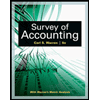
1.
Introduction: The transfer price refers to the price at which the goods and services are exchanged between companies under common control or between divisions of the same company.
The value of the lowest acceptable transfer price for the selling division, the highest acceptable transfer price for the buying division, the range of acceptable transfer price and will the managers voluntarily agree to transfer the units along with the reasons for the same.
2.
Introduction: The transfer price refers to the price at which the goods and services are exchanged between companies under common control or between divisions of the same company.
To explain: The effect on the profits of the P Division, C division, and the entire company due to the change in the supply price of the P division.
3.
Introduction: The transfer price refers to the price at which the goods and services are exchanged between companies under common control or between divisions of the same company.
The value of the lowest acceptable transfer price for the selling division, the highest acceptable transfer price for the buying division, the range of acceptable transfer prices and will the managers voluntarily agree to transfer units within the divisions along with the reason for the same.
4.
Introduction: The transfer price is the price that is charged by one department of the company to another department of the same company for the transfer of goods and services.
The P Division should meet the price of the outside supplier or not.
The effect on the profits of the company as a whole when the P Division does not meet the price of the outside supplier.
5.
Introduction: The transfer price is the price that is charged by one department of the company to another department of the same company for the transfer of goods and services.
Whether the C Division should purchase from the P Division at a higher price for the good of the company as a whole.
6.
Introduction: The transfer price is the price that is charged by one department of the company to another department of the same company for the transfer of goods and services.
The effect on the profits of the company as a whole when the C Division is required to purchase 5,000 tons of pulp each year from the P Division at $70 per ton.
Want to see the full answer?
Check out a sample textbook solution
Chapter 11 Solutions
MANAGERIAL ACCT. F/MANAGERS (LL)-W/ACCES
- 1. Define working capital and explain its importance in financial health and liquidity management. 2. Assess how the matching concept and accrual basis affect the reporting of current assets and liabilities. 3. Using a hypothetical balance sheet (you may create one), identify at least 5 current assets and 5 current liabilities and analyze how changes in these elements affect liquidity ratios. 4. Recommend at least two strategies VinGrenDom Ltd. can implement to optimize working capital.arrow_forwardNonearrow_forwardNo Ai Answerarrow_forward
- I need the correct answer to this financial accounting problem using the standard accounting approach.arrow_forwardTheron Interiors manufactures handcrafted cabinetry and uses a process costing system. During the month of October, the company started Production on 720 units and completed 590 units. The remaining 120 units were 60% complete in terms of materials and 40% complete in terms of labor and overhead. The total cost incurred during the month was $45,000 for materials and $31,200 for labor and overhead. Using the weighted-average method, what is the equivalent unit cost for materials and conversion costs (labor and overhead)?arrow_forwardGeneral Accountingarrow_forward
- Kamala Khan has to decide between the following two options: Take out a student loan of $70,000 and study accounting full time for the next three years. The interest on the loan is 4% per year payable annually. The principle is to be paid in full after ten years. Study part time and work part time to earn $15,000 per year for the following six years. Once Kamala graduates, she estimates that she will earn $30,000 for the first three years and $40,000 the next four years. Kamala's banker says the market interest for a ten-year horizon is 6%. Required Calculate NPV of the ten-year cash flows of the two options. For simplification assume that all cash flows happen at year-end. Based on the NPV which of the two options is better for Kamala?arrow_forwardFinancial Accountingarrow_forwardPlease give me answer with general accountingarrow_forward
 Survey of Accounting (Accounting I)AccountingISBN:9781305961883Author:Carl WarrenPublisher:Cengage Learning
Survey of Accounting (Accounting I)AccountingISBN:9781305961883Author:Carl WarrenPublisher:Cengage Learning
